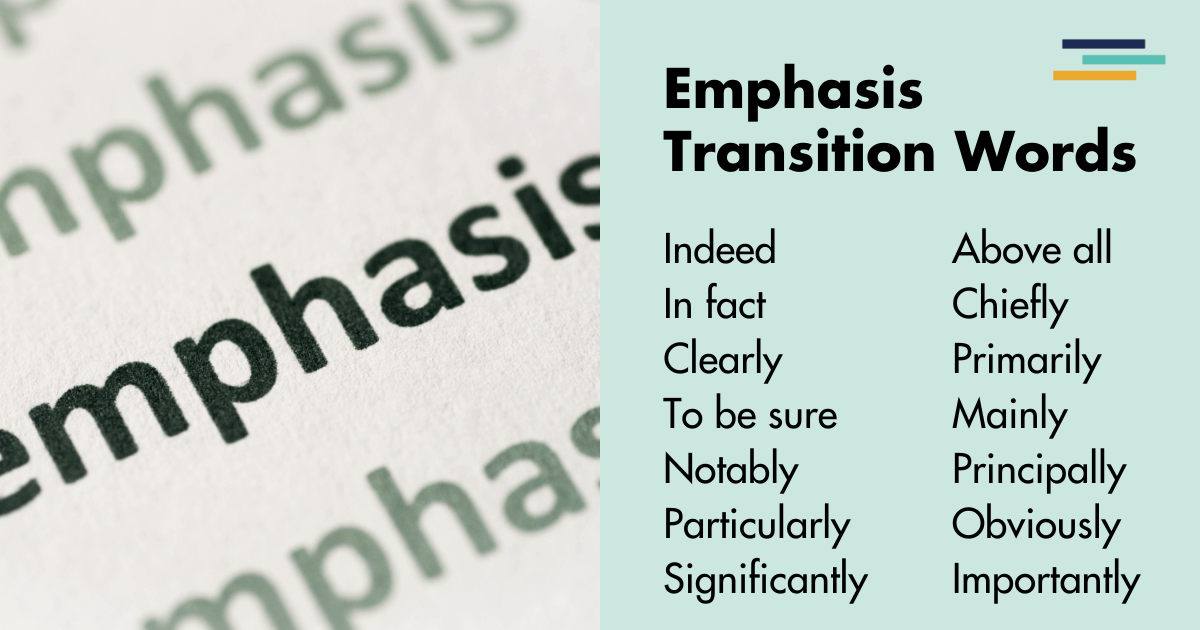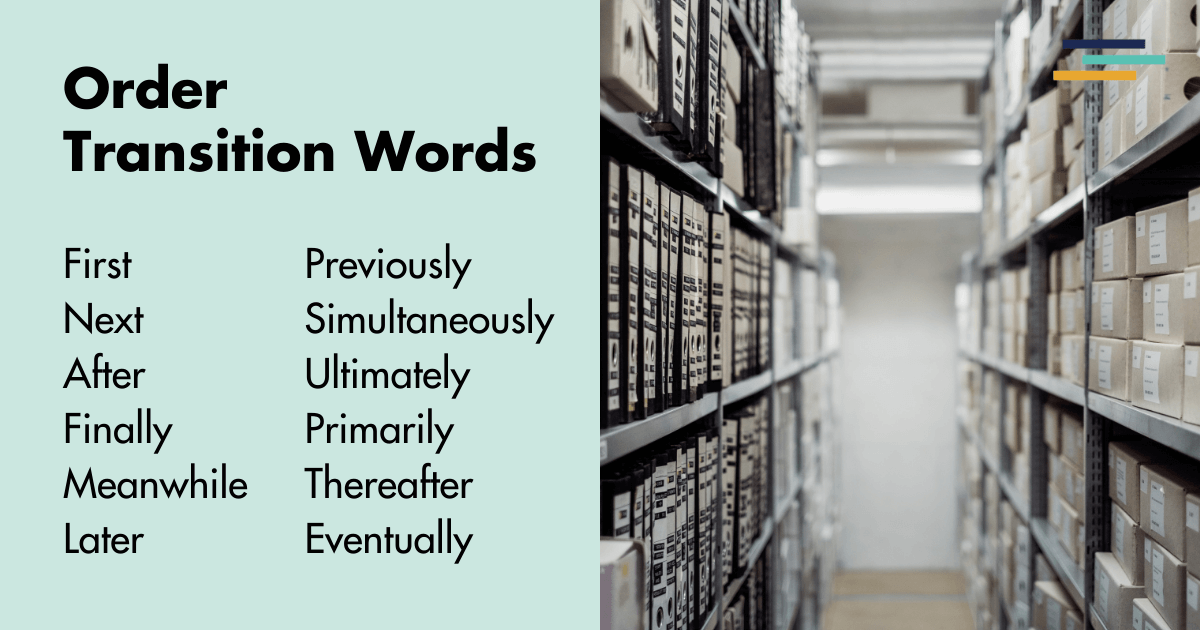
It doesn’t matter what type of writing you’re doing. It could be an email to your newsletter list, a social media post, or your latest novel. Either way, mastering narrative flow is crucial. And the best way to get flow into your writing is to use transition words. Transition words make your writing clear and cohesive. And they also make sure readers can follow the structure of your sentences logically.
If you don’t handle transitions well, your writing will feel disjointed and readers will scratch their heads in irritation because your prose will be hard to follow.
If you want to learn more about how to use transition words, or just need a brief refresher, then this article is for you. We’re going to delve into what transition words are, why they’re important, and how you can use them to enhance your writing. You’ll also get to know the different transition words (along with 94 examples) and, if you stick around until the end, I’ve included my top three tips for using transition words effectively.
What Are Transition Words?
Transition words are essential to great writing. They help you connect your ideas so that your sentences, paragraphs, scenes, chapters, and ultimately, your novel make sense. I like to think of transition words as bridges because they link one thing to another.
Transition phrases can be simple, single words like “and,” “but,” “so,” and “because.” They can also be more complex phrases like “in addition,” “on the other hand,” and “as a result.”
Transition words exist to create coherency between your ideas, so they make logical connections between one part of a sentence and the next. They can help you with addition, contrast, cause and effect, and time. By using these transition words, readers will understand the progression of your thoughts.
Transition words will help make your writing easier to read.

Why Are Transition Words Important?
Without transition words, your writing will look choppy and there will not be a logical flow, making it hard for readers to comprehend your meaning. If readers can’t understand the flow of your writing, they won’t be able to enjoy your work, which will lead to them putting your book down.
Transition words act as really effective signposts in your writing because they show readers where you’re adding information, presenting a causal relationship between two concepts, making a contrast between two parts of your sentence, shifting time or setting, etc. For example, words like “however” and “on the other hand” tell the reader you’re about to draw a contrast between two ideas, whereas words like “additionally” and “furthermore” signal you’re about to add to an idea.
Can you see how transition words eradicate abrupt jumps between sentences and paragraphs, making your writing smoother and less jarring? These words are vital because they enhance readability and strengthen the impact of any arguments you make.
If you want to write in a persuasive and interesting way, then you need a bunch of transition words in your writerly arsenal.
The important thing to remember is that without the use of transition words, readers would find it hard to understand the ideas (character, plot, setting) you’re trying to communicate, and that’s why they’re so important.
What Roles Do Transitions Play in Writing?
This article covers four major roles transition words play in your writing. These roles are emphasis, addition, order, and contrast. In the following section, you’re going to learn about each of these roles, and I’ll provide examples so you can see how they work in practice.
Let’s start with emphasis transition words.
What Are the Different Types of Transition Words?
Emphasis Transition Words
Emphasis transition words are crucial for highlighting important points in your writing. They help draw attention to key ideas, ensuring your readers grasp the significance of specific details. These words can make your writing more persuasive and impactful by underscoring essential elements.
- Indeed: The results of the experiment were indeed groundbreaking.
- In fact: She is, in fact, the best candidate for the job.
- Clearly: Clearly, this issue needs immediate attention.
- Obviously: Obviously, the project requires more funding to succeed.
- Undoubtedly: This is undoubtedly the most effective solution we have.
- To be sure: To be sure, he has proven himself a reliable leader.
- For this reason: For this reason, we must reconsider our strategy.
- Notably: Notably, her performance was exceptional.
- Particularly: He was particularly skilled at solving complex problems.
- Especially: The dessert was especially delicious.
- Importantly: Importantly, the data supports our hypothesis.
- Significantly: Significantly, the changes improved overall efficiency.
- Above all: Above all, the safety of the students is our priority.
- Chiefly: The plan succeeded chiefly because of her leadership.
- Primarily: We delayed the project primarily because of bad weather.
- Mainly: Technical issues caused the delay, mainly.
- Principally: Principally, we aimed the initiative at reducing costs.
- Most importantly: Most importantly, we should focus on customer satisfaction.
These emphasis transition words can enhance your writing by making key points stand out and ensuring your readers understand the importance of the information you are conveying.

Addition Transition Words
Addition transition words help to add information or ideas to your writing, creating a smoother flow and connecting related points. They are essential for expanding on arguments, providing examples, or simply adding more detail to your narrative.
- Additionally: Additionally, the new policy will improve employee morale.
- Also: She is a talented singer and also plays the piano beautifully.
- And: He enjoys reading and writing.
- Furthermore: The project was successful. Furthermore, we completed it early.
- Moreover: The results were impressive. Moreover, they exceeded our expectations.
- In addition: In addition to his skills, he has a great attitude.
- Besides: She has a beautiful voice. Besides which, she can dance well. So, if the singing career doesn’t work out, she has a backup plan.
- Too: He likes football. He loves basketball too.
- As well: She works hard and volunteers as well.
- Along with: Along with his technical skills, he has excellent communication abilities.
- Plus: She’s an excellent designer. Plus, she’s very organized.
- Further: Further, we need to address the budget concerns.
- Likewise: The team performed well. Likewise, their coach received praise.
- Similarly: The weather was bad. Similarly, the traffic was terrible.
- Not only… but also: Not only is she intelligent but also very creative.
- Equally: He is equally skilled in both painting and sculpture.
- Additionally: The report was thorough. Additionally, it was easy to read.
- Apart from: Apart from being an outstanding leader, she is also a kind person.
- As well as: She’s knowledgeable as well as experienced.
- Alongside: Alongside the financial report, we need the marketing analysis.
These addition transition words will help you seamlessly incorporate new ideas or details into your writing, ensuring that your prose flows logically and cohesively.
Order Transition Words
Order transition words are essential for organizing your ideas and presenting them in a logical sequence. They guide the reader through your argument or narrative, ensuring clarity and coherence.
- First: First, we need to gather all the ingredients.
- Second: Second, preheat the oven to 350 degrees.
- Third: Third, mix all the ingredients thoroughly.
- Next: Next, pour the mixture into a baking pan.
- Then: Then, place the pan in the oven.
- After: After you’ve baked the cake, let it cool for 20 minutes.
- Following: Following the cooling process, apply the frosting.
- Subsequently: Subsequently, cut the cake into equal pieces.
- Finally: Finally, serve the cake with a scoop of ice cream.
- At the same time: At the same time, prepare the coffee.
- Meanwhile: Meanwhile, set the table for dessert.
- Earlier: Earlier, we had prepared the frosting.
- Before: Before serving, ensure the cake is completely cool.
- Afterward: Afterward, clean the kitchen.
- Initially: Initially, we thought the recipe would be difficult.
- Later: Later, we realized it was quite simple.
- Previously: Previously, I had never baked a cake.
- Simultaneously: Simultaneously, start making the icing.
- Immediately: Immediately after baking, the aroma filled the house.
- Finally: Finally, enjoy your delicious homemade cake.
- Ultimately: Ultimately, the success of the cake depends on the ingredients.
- Primarily: Primarily, focus on the baking time.
- First and foremost: First and foremost, ensure you have all the ingredients.
- Once: Once the cake is ready, everyone will enjoy it.
- To begin with: To begin with, preheat the oven.
- In the beginning: In the beginning, gather all the ingredients.
- Thereafter: Thereafter, follow the steps carefully.
- Eventually: Eventually, you will master the recipe.
- In conclusion: In conclusion, baking can be a rewarding experience.
These order transition words will help you structure your writing in a clear and logical sequence, making it easier for your readers to follow your narrative or argument.

Contrast Transition Words
Contrast transition words are used to highlight differences between ideas or to show how they contrast with each other. These words help to create a clear distinction and provide a nuanced understanding of the relationship between ideas.
- However: She wanted to attend the party. However, she had to work late.
- But: He studied hard for the test but he didn’t pass.
- Yet: The sun was shining, yet it felt cold outside.
- Although: Although it was raining, they went for a walk.
- Despite: Despite his efforts, he couldn’t complete the project on time.
- On the other hand: She loves classical music. On the other hand, her brother prefers rock.
- In contrast: The north side of the island is dry. In contrast, the south side is lush.
- Nevertheless: He had little experience. Nevertheless, we hired him for the job.
- Whereas: She likes coffee, whereas her friend prefers tea.
- Conversely: The medicine made him feel better. Conversely, it made her feel worse.
- Even though: Even though it was late, they continued their journey.
- Though: Though he was tired, he continued to work.
- Instead: She didn’t go to the gym. Instead, she took a long walk.
- Unlike: Unlike her classmates, she finished her homework early.
- Otherwise: You need to hurry; otherwise, you’ll miss the train.
- Rather: He chose to stay home rather than go out.
- Nonetheless: The team was under-prepared. Nonetheless, they won the game.
- Alternatively: You can take the bus. Alternatively, you can walk.
- Still: He apologized, still she was upset.
- Yet: It was a laborious task, yet she completed it.
- Though: Though he tried, he couldn’t fix the car.
- While: She was cooking while he set the table.
- Conversely: We praised her for her work. Conversely, we criticized him.
- Otherwise: You should wear a coat, otherwise you might catch a cold.
- Even so: It was raining. Even so, they went hiking.
- In spite of: In spite of the warnings, they went ahead with their plan.
- On the contrary: He thought the project would fail. On the contrary, it succeeded.
- Rather than: Rather than complaining, she took action.
- Though: Though she was nervous, she gave a brilliant speech.
These contrast transition words will help you clearly differentiate between ideas and provide a more nuanced and detailed understanding in your writing.
Tips for Using Transition Words
Tip 1: Use Transition Words to Enhance Clarity and Flow
If you want to write clearly and smoothly, you must add transition words to your writing. If you don’t use transition words, your writing won’t flow, and your author’s voice won’t feel natural.
These words and phrases help guide readers through your novel, ensuring they never feel lost and always understand what you’re saying.
In short, they will reduce confusion and create a seamless reading experience.
And who doesn’t want that?
Tip 2: Match Transition Words to the Tone and Style of Your Writing
Don’t get me wrong, you could pick any transition word that makes grammatical sense in the sentence you’re writing, and that would be fine.
But…
If you want to know a secret to supercharge your writing, then stick with me. Have you ever thought about using these words to match the tone and style of your writing? No? Then pay attention.
Let’s just say you’re writing a historical fiction novel set in upper-class regency England. In this instance, you might find words like “furthermore,” “consequently,” and “nevertheless,” work better, because they convey the upper class tone of the novel and fit with the way characters might talk.
Now imagine you’re writing a gritty, contemporary thriller where the protagonist has a blunt, no nonsense personality. In order for your transition words to match the tone and style of your writing, you might use simpler iterations like “but,” “so,” and “also.”
Tone is nothing more or less than genre expectations, so have a think about what transition words work best for your genre, and you won’t disappoint readers.
Tip 3: Vary Transition Words to Avoid Repetition
If you’ve read any of my previous articles, you know repetition and I don’t get along. And that’s because repetition bores readers. It makes writing monotonous and less engaging, which is the exact opposite of what we’re trying to do here.
By varying your use of transition words, you keep your writing fresh and engaging for readers.
And, now you’ve read this article, you have plenty of transition words to choose from.
Finally, always remember the story comes first. Before worrying about the perfect adjective to use, it’s best to focus on:
- Creating engaging characters
- Penning an interesting plot
- Structuring solid settings
A tool like Fictionary helps you turn your draft into an interesting story readers love. So, with the right adjectives and a strong narrative foundation, your writing can truly shine.


